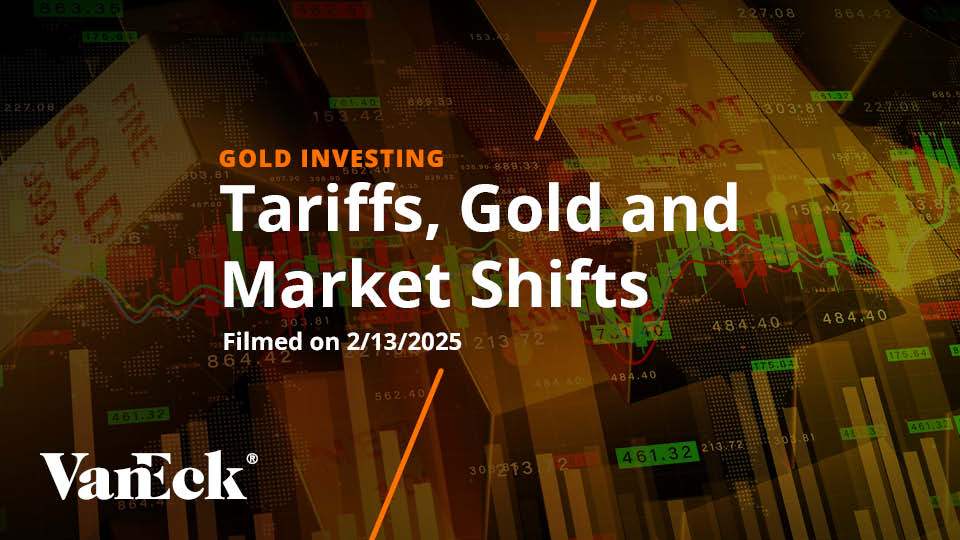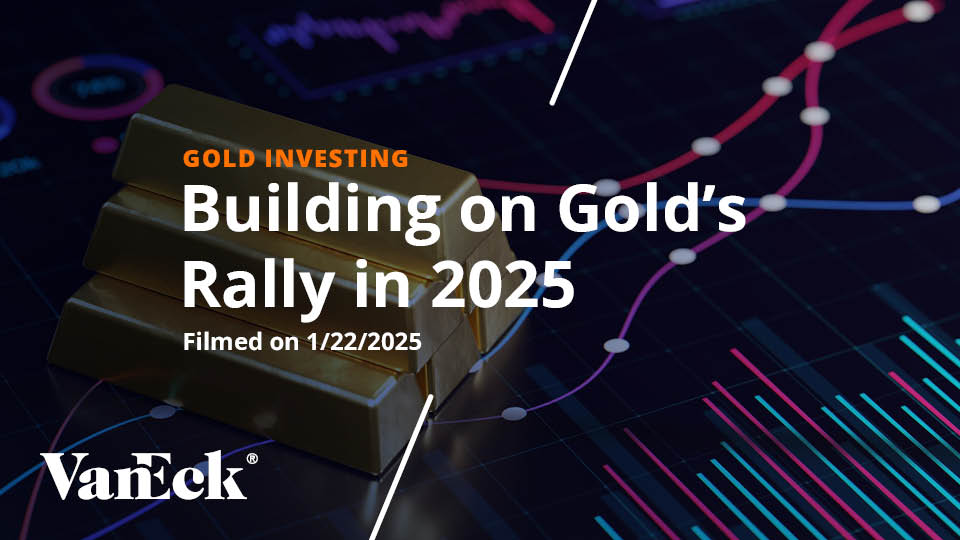Riding the Gold Wave: Record Prices, Strategic Mergers and Miners' Resilience
04 April 2025
Read Time 7 MIN
Monthly gold market and economic insights from Imaru Casanova, Portfolio Manager, featuring her unique views on mining and gold’s portfolio benefits.
Equity Turbulence Boosts Gold’s Shine
U.S. equity markets experienced significant declines during the month of March. Driven by concerns over new tariff implementations and their potential impact on the global economy, both the S&P 5001 and the Nasdaq Composite2 entered correction territory on March 13, after dropping more than 10% from their February 19 peak. The unpredictability of economic policies and heightened market volatility bolstered gold's appeal, reaffirming its role as the preferred safe-haven asset during times of global uncertainty. The spot gold price recorded new all-time highs during the month, surpassing the $3,000 per ounce mark on March 14 and closing at a record price of $3123.57 on March 31, a 9.30% ($265.73) monthly gain.
Gold Miners Outperform Amid Market Weakness
The gold miners, as represented by the NYSE Arca Gold Miners Index (GDMNTR)3, outperformed significantly (up 15.51% during the month), showcasing not only their leverage to the gold price, but also their attractive valuations relative to the broader equity markets, and their role as an effective portfolio diversifier due to their low correlation with most other asset classes. The S&P 500 and the NASDAQ composite ended the month down 5.63% and 8.14%, respectively.
Investment Demand Signals Sentiment Shift
The contrasting performances highlight a shift in investor sentiment towards gold and related equities. Increasing investment demand for gold translated into another month of strong inflows for the gold bullion backed ETFs, with holdings up 2.82% during the month. More importantly, according to LSEG Lipper data, this surge in investor interest in the gold sector led to the largest monthly net inflows in more than a year for funds that invest in gold miners, reversing a trend of persistent net outflows over the last couple of years. Funds investing in physical gold and gold derivatives attracted net $17.8 billion in 2024, the highest in five years, while funds investing in gold miners lost net $4.6 billion, the most in a decade.
Chasing the Vein: Fund Flows into Gold Miners
Source: Mining.com. Data as of March 21, 2025. Note—data covers 493 funds with combined assets under management of $62 billion.
Surging gold prices are driving record cash flow for gold producers, and when paired with rising stock valuations, are creating a more favorable climate for mergers and acquisitions (M&A) within the sector. Gold miners led the way in metals and mining M&A in 2024, according to research from S&P Global Market Intelligence, which revealed that gold deals made up 70% of the total transaction value. The report highlighted 62 gold-focused transactions during the year—representing a 32% increase from 47 deals in 2023.
M&A Momentum: Gold Sector Takes the Lead
We believe one of the key factors supporting a re-rating of the gold equity sector is a balanced approach to capital allocation. Investors’ desire for dividends and share buybacks must be satisfied, but to remain competitive and attract business, companies must deliver growth. That growth doesn’t necessarily have to be annual production growth, to be clear. We are looking for companies that can grow the life of their existing assets, their reserves, their margins, their per share metrics and their rates of return. Growth can be achieved organically—through the drill bit, optimizations, efficiencies and expansions—and is certainly our preferred approach. However, growth can also be acquired through M&A. While not as economically attractive as organic growth, it remains an important—if not essential—component of any mid-tier or large gold producer’s growth strategy.
Diverging Deals: A Critical Look at Recent Mergers
Recently announced/proposed M&A transactions include the acquisition of De Grey Mining (1.9% of Strategy net assets) by Northern Star Resources (1.6% of Strategy net assets); the merger of Equinox Gold (not held) and Calibre Mining (0.3% of Strategy net assets); the acquisition of Spartan Resources (1.8% of Strategy net assets) by Ramelius Resources (not held); and a public offer by Gold Fields (3.8% of Strategy net assets) to acquire Gold Road Resources (not held), which has been rejected by the board of Gold Road Resources.
We are not supportive of the friendly, at-the-market merger between Equinox Gold and Calibre Resources, announced on February 23, 2025. The implied market capitalization of the combined company was estimated at around CAD$7.7 billion. We don’t see any synergies between any of the companies’ operations. Both operate in the Americas, but in vastly different locations. Calibre is ramping up its Valentine Gold Mine in Newfoundland, Canada. This is a transformational asset that will vault the company to mid-tier status. Construction is progressing as planned and we expected Calibre shares to have a positive re-rate once it achieves commercial production later in 2025. The terms of the proposed combination, which is subject to shareholder approval, do not include a takeover premium for Calibre shareholders. In our view, a premium would be necessary to justify Calibre shareholders walking away from the share price appreciation they were likely to realize as the company transformed itself into a multi-asset producer with a flagship asset in Canada.
In contrast, the other three transactions we are highlighting here (all coincidently involving the acquisition of assets in Australia) offer obvious regional and operational synergies, along with significant takeover premiums.
Strategic Consolidations in Australia
On December 2, 2024, Australian major Northern Star Resources, announced an AUD$5 billion friendly acquisition of De Grey Mining at a 37.1% premium to the prior day’s close. The deal is expected to close in the second quarter of this year. Northern Star is probably the company that is best suited to develop De Grey’s Hemi gold project. The company is established in Western Australia and has seen a tremendous growth trajectory over the past decade from scrappy junior to established mid-tier and now an emerging major. Their growth has come primarily from smart acquisitions, through which they have constantly created more value than expected through operational efficiencies and exploration. While Northern Star Resources is paying a generous premium for De Grey Mining, the land package offers upside from an additional five-million-ounce resource with exploration potential likely to extend the project’s life. Hemi also presents technical challenges due to metallurgically complex ores—challenges Northern Star Resources is well-equipped to handle. This project firmly establishes Northern Star Resources among the ranks of the world’s leading gold majors.
The Dalgaranga low-grade open pit operation in Western Australia opened in 2018, but by 2021, the junior company that owned it was failing due to poor planning and execution. Management was replaced, and in early 2022, new geologic ideas led to the discovery of the high-grade Never Never lode deposit beneath the pit. The unprofitable open pit was shut down, and in 2023 the company was recapitalized and renamed Spartan Resources. On March 17, 2025, Australian junior Ramelius Resources announced the friendly AUD$2.4 billion acquisition of Spartan at a 27.5% premium to the 30-day volume weighted average price. There are considerable synergies between the Dalgaranga properties and Ramelius Resources’ nearby Mt. Magnet operation that justify this premium. The merger will also transform Ramelius into a mid-tier producing a half-million ounces per year once Never Never is developed.
On March 25, 2025, senior gold producer Gold Fields made public an offer to acquire Gold Road Resources for a cash consideration that valued Gold Road Resources at AUD$3.3 billion, representing a 28% premium to its closing share price on March 21. Gold Fields already owns a 50% interest in and is the operator of the Gruyere mine in Western Australia. Gold Road holds the other 50% non-operating interest in the Gruyere joint venture, which is its only producing asset. The rationale is clear: consolidating ownership of the asset would allow Gold Fields to unlock the full potential of the Gruyere mine by eliminating dis-synergies stemming from the current joint venture structure. Gold Road Resources’ shareholders would have the opportunity to monetize their investment at a nice premium. It is now up to them to decide whether this is a good deal.
1S&P 500 Index is widely regarded as the best single gauge of large-cap U.S. equities. The index is a float-adjusted, market-cap-weighted index of 500 leading U.S. companies from across all market sectors including information technology, telecommunications services, utilities, energy, materials, industrials, real estate, financials, health care, consumer discretionary, and consumer staples. 2NASDAQ Composite Index is a broad-based market index that includes more than 3700 stocks listed on the Nasdaq stock exchange. 3NYSE Arca Gold Miners Index (GDMNTR) is a modified market capitalization-weighted index comprised of publicly traded companies involved primarily in the mining for gold.
Related Insights
IMPORTANT DEFINITIONS & DISCLOSURES
This material may only be used outside of the United States.
This is not an offer to buy or sell, or a recommendation of any offer to buy or sell any of the securities mentioned herein. Fund holdings will vary. For a complete list of holdings in VanEck Mutual Funds and VanEck ETFs, please visit our website at www.vaneck.com.
The information presented does not involve the rendering of personalized investment, financial, legal, or tax advice. Certain statements contained herein may constitute projections, forecasts and other forward looking statements, which do not reflect actual results. Information provided by third-party sources are believed to be reliable and have not been independently verified for accuracy or completeness and cannot be guaranteed. Any opinions, projections, forecasts, and forward-looking statements presented herein are valid as of the date of this communication and are subject to change without notice. The information herein represents the opinion of the author(s), but not necessarily those of VanEck.
The views contained herein are not to be taken as advice or a recommendation to buy or sell any investment in any jurisdiction, nor is it a commitment from Van Eck Associates Corporation or its subsidiaries to participate in any transactions in any companies mentioned herein. This content is published in the United States. Investors are subject to securities and tax regulations within their applicable jurisdictions that are not addressed herein.
All investing is subject to risk, including the possible loss of the money you invest. As with any investment strategy, there is no guarantee that investment objectives will be met and investors may lose money. Diversification does not ensure a profit or protect against a loss in a declining market. Past performance is no guarantee of future results.

